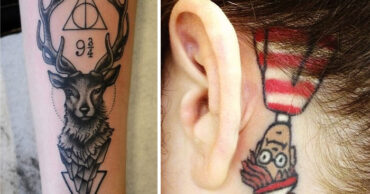Learning happens wherever we happen to be. And though we absolutely love cozy old libraries, they’re not the only way to expand your knowledge about the world. Even social media, with the help of high-quality photos, can help with that.
That’s where the ‘History Archaeology People’ Facebook page comes in. It is a project that is dedicated to educating and entertaining the internet with some of the most powerful photos from ages past. We’ve collected some of the most interesting images to share with you, Pandas, from buildings and artifacts to statues and works of art. They might just give you a whole new perspective about the history of the human race.
#1
Magnificent earring with Goddess Nike driving a two-horse chariot.
Greek, late Classical or Early Hellenistic Period.
About 350–325 B.C
Dimensions : Height: 5cm !!! , Weight: 15.8 gm .
Medium : Gold and enamel .

Image source: History Archaeology People
#2
Medusa sculpture at Hadrian’s Villa,Tivoli ( 2nd century AD).

Image source: History Archaeology People
#3
Golden chariot found in King Tutankhamun’s tomb

Image source: History Archaeology People
#4
ARCHAEOLOGY
One of biggest pre-roman mosaics ever found. Highly elaborate, meant to show power of Kingdom of Macedonia.
Palace of Aigai, known today as Vergina, is considered not only biggest, but together with Parthenon, most significant building of classical Greece.
Constructed during reign of Philip II (359-336 BC) on a raised outcrop in Vergina in northern Greece, palace, a remarkable landmark and symbol of power and beauty three times size of Parthenon, was visible from whole Macedonian basin.

Image source: History Archaeology People
#5
Magnificent roman mosaic of Zeugma (Turkey).It represents the myth of Queen Pasiphaé (sitting on her throne).
Situated in South-eastern Turkey, Zeugma, literally “bridge” or “crossing” in ancient Greek, owes its name to the fact that it was located at the major ancient crossing point on the river Euphrates. The ancient term Zeugma actually referred to the twin cities on the opposing banks of the river. They were Hellenistic settlements established by commander Seleucus Nicator around 300 BCE.

Image source: History Archaeology People
#6
Greek Gold Diadem, Black Sea , ca. 300 BC

Image source: History Archaeology People
#7
Ptolemaic Temple of the Goddess Hathor at Nitentóre (Dendera):
The western staircase leading to the roof of the Temple.
On the wall at right, detail of the procession : four priests carrying shrines .

Image source: History Archaeology People
#8
Hellenistic Piece.
Artemis with quiver , gold hairnet.

Image source: History Archaeology People
#9
Erechtheion – Caryatids
Ancient Greek temple on the north side of the Acropolis of Athens.
Caryatid, greek: Καρυάτις – Karyatid, literally means “maiden of Karyai”
Caryatid is the name given to an architectural column which takes the form of a standing female figure. The first examples come from ancient Greek architecture .

Image source: History Archaeology People
#10
Sphinx of Lanuvium.
Near Rome. Roman, about AD 120–140.

Image source: History Archaeology People
#11
Top of the Great Pyramid of Giza

Image source: History Archaeology People
#12
Holy triad of the Osiris family (Horus, Osiris and Isis).
Gold and lapis lazuli .Was once part of an pendant and bears the Cartouche of Pharao Osorkon II as well as an inscription at the bottom. Egypt, 22nd dynasty. 874 to 850 BC.

Image source: History Archaeology People
#13
The Dark Queen, statue probably depicting the Ptolemaic queen Cleopatra III (ruled 142–101 BC).
Discovered in the lost, sunken city of Thonis-Heracleion
Lost city of Heraklion
Port of Thonis-Heraklion ,a lost ancient Egyptian city submerged beneath the sea 1,200 years ago .
Heraklion (Greek: Ἡράκλειον), also known as Thonis (Θῶνις), was an ancient Egyptian city near Alexandria whose ruins are located in Abu Qir Bay, currently 2.5 km off the coast, under 10 m (30 ft) of water.
Its importance grew particularly during the waning days of the Pharaohs—the late period, when it was Egypt’s main port for international trade and collection of taxes.
Heracleion was originally built on some adjoining islands in the Nile Delta, and was intersected by canals. It possessed a number of harbors and anchorages, was the sister city of Naucratis, and was superseded by Alexandria.
Giant 16 foot statues have been uncovered and brought to the surface while archaeologists have found hundreds of smaller statues of minor gods on the sea floor.
Slabs of stone inscribed in both ancient Greek and Ancient Egyptian have also been brought to the surface.
Dr Damian Robinson, director of the Oxford Centre for Maritime Archaeology said :
“The site has an amazing preservation ,
“We are getting a rich picture of things like the trade that was going on there and the nature of the maritime economy in the Egyptian late period. There were things were coming in from Greece and the Phoenicians.

Image source: History Archaeology People
#14
Temple of Nefertari.

Image source: History Archaeology People
#15
Egyptian mummy mask, 19th dynasty, reign of Ramses II (wood).
In this carved image that seems to come to life, you can once again appreciate the talent of the ancient Egyptian artists.

Image source: History Archaeology People
#16
Roman mask helmet

Image source: History Archaeology People
#17
The Celsus Library, Ephesus.
This is one of the most beautiful structures in Ephesus. It was built in 117 A.D. to store about 12,000 scrolls and to serve as a mausoleum for Tiberius Julius Celsus Polemaeanus (Roman proconsul of Ephesus).
The scrolls of the manuscripts were kept in cupboards in niches on the walls.There were double walls behind the bookcases to prevent them from the extremes of temperature and humidity.
The capacity of the library was more than 12,000 scrolls. It was the third richest library in ancient times after the Alexandria and Pergamum.
The facade of the library has two levels , with Corinthian style columns on the ground floor and three entrances to the building. There is three windows openings in the upper floor.
The statues in the niches of the columns today are the copies of the originals. The statues symbolize wisdom (Sophia), knowledge (Episteme), intelligence (Ennoia) and valor (Arete).
The interior of the library was destroyed, supposedly by an earthquake in 262 A.D., (though other evidence points to a fire during a Gothic invasion in that same year).

Image source: History Archaeology People
#18
Roman aqueduct of Segovia – Spain

Image source: History Archaeology People
#19
Venus de Milo.
Evacuation of the Louvre during WWII.

Image source: History Archaeology People
#20
Great model of imperial Rome.
Exhibited in the Museum of Roman Civilization, it is a square of about 24 meters on a side, which can be seen from the upper floor. Its construction began in 1933 by the architect Gismondi, according to the detailed archaeological map drawn at the end of the century by Rodolfo Lanciani. The model is updated with the latest archaeological findings.

Image source: History Archaeology People
#21
Bronze Head of King Sargon of Akkad, 2306 B.C
“The head of Sargon plainly has been mutilated. In addition to the severing of the head from its lost body, the image bears various marks of violence—the left eye socket has been gouged out, the nose has been flattened at the tip, the ears have been cut off, and the ends of the beard have been broken. Although it has been suggested that the eye socket was damaged by someone attempting to remove an inset of precious material, there is no evidence that the hole ever contained anything at all and, in any case, the other damage still demands explanation. The desecration of the royal portrait was almost certainly intentional and most likely an act of political iconoclasm, possibly carried out at the time of Nineveh’s fall to the Medes and Babylonians in the early seventh century BCE. The selective disfiguration of the head suggests that the goal was not to wipe away all presence of the royal figure, but rather to leave it in a state of defeat and humiliation.”

Image source: History Archaeology People
#22
Submerged Statue of Baia City
Baia was an ancient Roman town situated on the northwest shore of the Gulf of Naples. It was a fashionable resort for centuries in antiquity, particularly towards the end of the Roman Republic, when it was reckoned as superior to Pompeii, Herculaneum and Capri by people rich who built luxurious villas here from 100 BC.
The lower part of the town later became submerged in the sea due to local volcanic seismic activity .

Image source: History Archaeology People
#23
Greek traces in Asia.
A magnificent hybrid Greek and Oriental image.
Ceremonial Plaque depicting Cybele on her chariot, early 3rd century B.C.Afghanistan, Aï Khanum.
One of the oldest antiquities found at Aï Khanum, this spectacular disk depicts Cybele, the goddess of nature, and Nike, the personification of Victory, on a chariot drawn by two lions through a mountainous landscape. It is a remarkable example of hybrid Greek and Oriental imagery that typified the arts of Hellenized Asia. Ancient Near Eastern features include: the parasol—a royal symbol—here held by a priest; the stepped altar; the shape of the chariot; the scalloped pattern indicating mountainous terrain; and the moon crescent and the star. The cult of Cybele originated in Anatolia but had long been adopted by the Greeks. Also borrowed from the Greek tradition are the representation of the winged Nike, the bust of the sun god Helios, and the naturalistic rendering of the drapery and the lions. The overall composition of the scene, however, lacking any indication of perspective, is more typical of Near Eastern art.
Materials & dimensions:
Gilded silver; D. 1/25–2/25 in. x Diam. 9 7/8 in. (1–2 mm x 25 cm)
National Museum of Afghanistan, Kabul, 04.42.7

Image source: History Archaeology People
#24
Mask of Tutankhamun,topped by the royal insignia of the “Two Ladies”.

Image source: History Archaeology People
#25
Archeo news.
A group of 12 Medieval Underground Tombs discovered in China. These beautiful structures to protect wealthy dead in afterlife, dating from Yuan Dynasty (1271-1368 CE) were discovered during archaeological research in Jinan, Shandong Province in eastern China.

Image source: History Archaeology People
#26
Votive double axe
Early Aegean, Minoan
About 1550–1500 B.C.
Dimensions: Length 9 cm ; width 8.3 cm .
Gold double axe composed of thin sheet gold mounted on a hollow gold shaft and outlined by bands of five incised lines. On left blade, inscription of four undeciphered signs . Two pierced holes on right blade.
The axe was deposited in a sacred cave as a votive offering.

Image source: History Archaeology People
#27
HATSHEPSUT (1507 A.C. – 1456 A.C. )
Karnak, Obelisk of nearly 30 meters high and 350 tons.

Image source: History Archaeology People
#28
Magnificent ptolemaic Diadem (225–175 B.C.).
Part of Ptolemaic Jewelry Collection (16) – Getty Museum
Made in Egypt probably Alexandria.
Medium: Gold with various inlaid and attached stones, including garnet, cornelian, pearl, bone, moonstone, amethyst, emerald, and glass paste
This diadem has a cord allowing an fit and a Herakles knot clasp known for its apotropaic powers and its status as a symbol of fertility.
It seems possible that the original owner was a woman of the exclusive circle of dynastic princesses, who, ornamented in her golden finery, served the queen in one of the royal cults.

Image source: History Archaeology People
#29
Hagia Sophia
The Hagia Sophia is an enormous architectural marvel in Istanbul, Turkey, that was originally built as a Christian basilica nearly 1,500 years ago.
The Hagia Sophia anchors the Old City of Istanbul and has served for centuries as a landmark for both Christians and Muslims, as its significance has shifted with that of the dominant culture in the Turkish city.

Image source: History Archaeology People
#30
Bf 109 under wind tunnel experiment.
WW2

Image source: History Archaeology People
 Follow Us
Follow Us





